
Concept explainers
(a)
To find: the interval of time was M traveling fastest.
(a)
Answer to Problem 44AYU
The maximum value of
Explanation of Solution
Given information:
The following sketch represents the speed
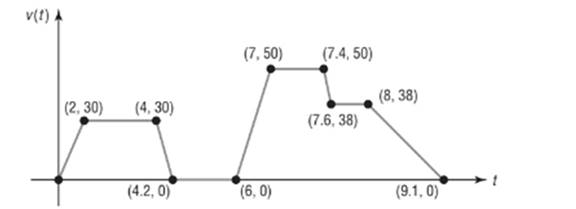
Calculation:
From the graph, the maximum value of
(b)
To find: the interval of time was M’s speed zero.
(b)
Answer to Problem 44AYU
The maximum value of
Explanation of Solution
Given information:
The following sketch represents the speed
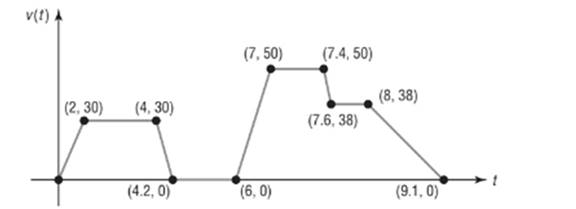
Calculation:
From the graph, the maximum value of
(c)
To find: the M’s speed between 0 and 2 minutes
(c)
Answer to Problem 44AYU
We can represent the function
Explanation of Solution
Given information:
The following sketch represents the speed

Calculation:
Between
(d)
To find: the M’s speed between 4.2 and 6 minutes
(d)
Answer to Problem 44AYU
The graph, the value of
Explanation of Solution
Given information:
The following sketch represents the speed
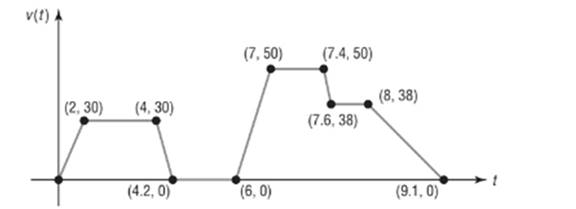
Calculation:
From the graph, the value of
(e)
To find: the M’s speed between 7 and 7.4 minutes
(e)
Answer to Problem 44AYU
The graph, the value of
Explanation of Solution
Given information:
The following sketch represents the speed
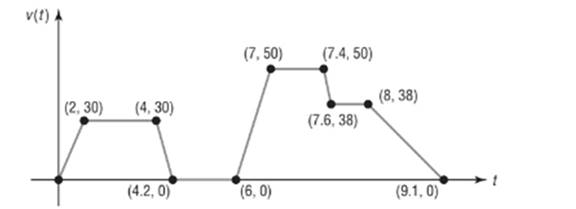
Calculation:
From the graph, the value of
(f)
To find: When M’s speed constant.
(f)
Answer to Problem 44AYU
Explanation of Solution
Given information:
The following sketch represents the speed
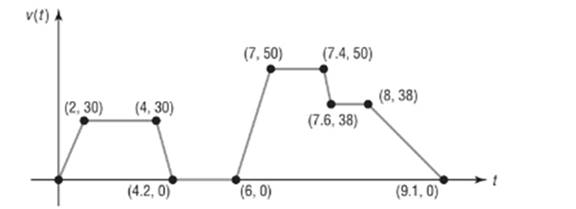
Calculation:
M’s speed is constant between the following time intervals.
Chapter 2 Solutions
Precalculus
Additional Math Textbook Solutions
A First Course in Probability (10th Edition)
Elementary Statistics: Picturing the World (7th Edition)
Elementary Statistics (13th Edition)
University Calculus: Early Transcendentals (4th Edition)
- The graph of f' is below. Use it to determine where the local minima and maxima for f are. If there are multiple answers, separate with commas. 2 f'(x) N -5 -4 3-2-1 -1 -2 -3 -4 12 3 4 5 -x Local minima at x Local maxima at xarrow_forwardThe graph of f' is below. Use it to determine the intervals where f is increasing. -5-4-32 4- 3 2 1 -2 -3 +x 2 3 4 5arrow_forwardThe graph of f' is below. Use it to determine where the inflection points are and the intervals where f is concave up and concave down. If there are multiple inflection points, separate with a comma. 6 5 4 3 2 1 f'(x) +x -6-5-4-3 -2 -1 1 2 3 4 5 6 -1 -2 -3 -4 -5 -6+ Inflection point(s) at x = Concave up: Concave down:arrow_forward
- The graph of f' is below. Use it to determine where the local minima and maxima for f are. If there are multiple answers, separate with commas. f'(x) 4- -5-4-3-8-1 3 2 1 x 1 2 3 4 5 -1 -2 -3 -4 Local minima at a Local maxima at =arrow_forwardThe graph of f' is below. Use it to determine the intervals where f is increasing. f'(xx) 4- -5 -3 -2 3 2 1 1 2 3 4 5 Cit +x 7 2arrow_forwardPlease focus on problem ii.arrow_forward
 Calculus: Early TranscendentalsCalculusISBN:9781285741550Author:James StewartPublisher:Cengage Learning
Calculus: Early TranscendentalsCalculusISBN:9781285741550Author:James StewartPublisher:Cengage Learning Thomas' Calculus (14th Edition)CalculusISBN:9780134438986Author:Joel R. Hass, Christopher E. Heil, Maurice D. WeirPublisher:PEARSON
Thomas' Calculus (14th Edition)CalculusISBN:9780134438986Author:Joel R. Hass, Christopher E. Heil, Maurice D. WeirPublisher:PEARSON Calculus: Early Transcendentals (3rd Edition)CalculusISBN:9780134763644Author:William L. Briggs, Lyle Cochran, Bernard Gillett, Eric SchulzPublisher:PEARSON
Calculus: Early Transcendentals (3rd Edition)CalculusISBN:9780134763644Author:William L. Briggs, Lyle Cochran, Bernard Gillett, Eric SchulzPublisher:PEARSON Calculus: Early TranscendentalsCalculusISBN:9781319050740Author:Jon Rogawski, Colin Adams, Robert FranzosaPublisher:W. H. Freeman
Calculus: Early TranscendentalsCalculusISBN:9781319050740Author:Jon Rogawski, Colin Adams, Robert FranzosaPublisher:W. H. Freeman
 Calculus: Early Transcendental FunctionsCalculusISBN:9781337552516Author:Ron Larson, Bruce H. EdwardsPublisher:Cengage Learning
Calculus: Early Transcendental FunctionsCalculusISBN:9781337552516Author:Ron Larson, Bruce H. EdwardsPublisher:Cengage Learning





